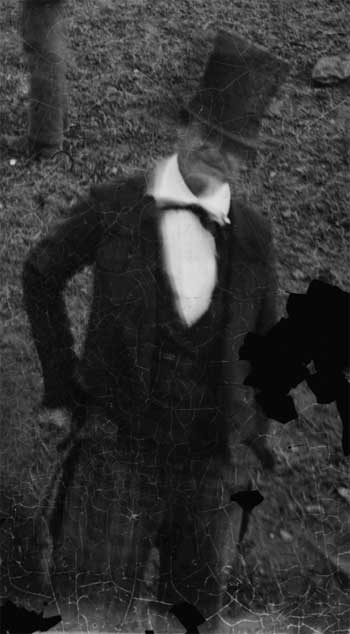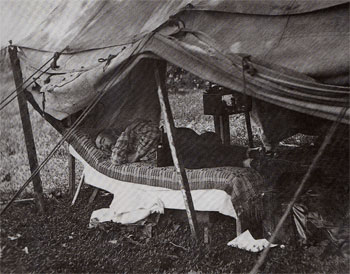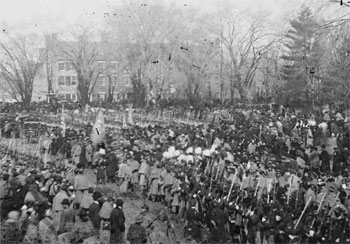Snapshots
15 January 2008

While chasing one of my boys, Lieutenant Colonel Samuel W. Owen, 3rd Pennsylvania Cavalry, I came on a photograph of him in an unusual setting. It made me think about how few casual or frivolous pictures–snapshots–I’ve can remember seeing among (probably) thousands of American Civil War-era images.
On reflection, this isn’t surprising. Due to the technical demands of wet-plate photography during the War, I’d expect most photographs to have a serious purpose. The long exposures and difficulty in preparing and developing photographs in the field probably made it less likely that photographers would risk wasting film on a moving subject or mundane scene.
Perhaps as a result, most surviving photographs are stiffly posed, and live subjects seem terribly aware of the camera. For fun, today, I’ve found a few with quite a different feel …
Here’s the one that started me off on this tangent:


LCol S.W. Owen, 3d Pa Cavalry, August 1862 (Library of Congress)
Colonel Owen is napping in his tent on the Virginia Peninsula, probably on a hot, muggy day. The tent flaps are pulled up to invite any passing breeze. I don’t know about you, but I can’t remember having ever seen another picture whose main subject is a soldier sleeping.
You’ll notice also he’s got company in the form of a bottle. It’s likely that that part of the picture is staged, as Owen was apparently the target of more than one prank while with the regiment, and there’s no indication of a drinking problem.
At the start of the War Samuel Owen commanded an independent cavalry company in Washington DC. His and other DC militia units were hurriedly mobilized for the defense of the Capital in that exciting April of 1861 before the arrival of the 7th New York Infantry and the many other regiments from the northern states that followed. He was then about 35 years old.
He accepted appointment as Lieutenant Colonel of the 3rd Pennsylvania Cavalry as that unit was completing its organization in Washington in August 1861. He served with the Regiment on campaign on the Peninsula and in Maryland, in command, as often as not, in the absence of Colonel Averell.
At Antietam he and his troopers accompanied General Hooker across the creek the afternoon before the great battle, and were among the first in combat in advance of the Federal First Corps that evening.
Ten days after Antietam Owen left the unit for Washington. He resigned his commission soon after that, in October 1862. Then his trail goes cold. He had a successful tailor business before the War and possibly returned to it. An 1890 Washington DC city directory lists only his widow, so he passed before then.

Soldiers warming at a fire (National Archives)
So, here’s another surprising image. Because of it’s casual framing and poses, I think it looks like it belongs in our century rather than theirs. I don’t know who these soldiers are or where they were photographed, but their story is easily understood.
Compare that to a more common photographic view of an Army camp:

Camp of 31st Pennsylvania Infantry near Washington, D.C. 1862 (Library of Congress)
I think the main reason the first picture–those cold soldiers– has such impact is the lack of focused awareness on the part of the subjects. It strikes me as a tiny piece of reality, or at least as close as we’re likely to get to it from nearly 150 years away.
Although the camp scene below it looks like a casual encounter, it is typical of many I’ve seen, and I’ll bet it was fairly carefully staged. It’s informative, surely, but not arresting.
Another example of a loosely composed shot with weight is this one of the Grand Review of the Army in Washington DC at the end of the War.


Grand review of the army, May 1865 (Library of Congress)
It was a huge and memorable event, and worthy of the effort to photograph it. There’s some sense of what Pennsylvania Avenue looked like filled with ranks of soldiers, though much detail is lost in the blur of mass and motion. It’s a photograph that says something. Of interest, particularly perhaps, is the regiment of black troops in the immediate foreground.
This picture is also a great reminder of why there isn’t much action photography from the period. It’s a bit hard to see what’s going on, exactly. ‘Course that’s half the fun for us of the 21st Century.
Last in this vein, here’s an image that’s been in the news recently.


Dedication ceremonies at the Soldiers’ National Cemetery, Gettysburg, 19 November 1863 (Library of Congress)
Quite aside from the Lincoln tease, this is a fascinating picture to examine at high magnification. The range of human activity is amazing. And it’s a true “candid”, in the sense that most of its subjects are unaware they are being captured on film. It brings down to us some of the energy of that day.
And that puckish character at the top of this post? He’s one of the few people who noticed the photographer as he was taking the picture on that momentous occasion in Gettysburg. He’s also an argument for not getting too excited about men wearing stovepipe hats.
Now that’s a snapshot.
_________________
Breaking news 1/17/2008
In a news release yesterday, the Library of Congress announced that the photo above of the marching troops was mis-identified, and was in fact taken at Lincoln’s second inauguration in March 1865. Apparently it’s not of the Grand Review in May.
I suppose my comments about the picture still apply, though my fun is spoiled just a little.
Thanks to Brian Dirck for the notice.
_________________
Notes
On the Gettysburg Dedication photo, the Library of Congress catalog page notes:
President Abraham Lincoln delivered his Gettysburg Address at the dedication. Examination of the image in 2007 by members of the Center for Civil War Photography indicates that Lincoln may be visible in the crowd when viewed through magnification. For additional information, see http://www.civilwarphotography.org/lincolngettysburg.html
Most of what I know of Lieutenant Colonel Owen comes from:
Bryan, Wilhelmus Bogart, A History of the National Capital: From its foundation through the period of the adoption of the Organic Act. 1790-1878, New York: New York: Macmillan, 1914, 1916. 2 Volumes;
and
Rawle, William Brooke (and Regimental History Committee), History of the Third Pennsylvania Cavalry, Sixtieth Regiment Pennsylvania Volunteers in the American Civil War, 1861-1865, Philadelphia: Franklin Printing Company, 1905.
All the photographs above are from the Library of Congress (and linked to more information in the captions) except the depiction of the three soldiers around a fire, which is from the National Archives, as reproduced on the cover of
Woodhead, Henry, editor, Voices of the Civil War: Soldier Life, Alexandria (Va): Time-Life Books, 1996.
For more about wet plate and other kinds of 19th Century photography, see the Library of Congress page on the subject or a PBS feature.


January 16th, 2008 at 11:36 am
Brian,
What sort of information are you looking for on Owen?
Eric
January 16th, 2008 at 12:08 pm
A-ha, Eric!
Other than the sleepy photo above, all I have is here: http://aotw.org/officers.php?officer_id=333
I don’t know much about him either pre- or post-War, or why he resigned in Oct ’62. There’s an anecdote about him in camp on the Peninsula in the regimental I’ve read, but not much else that’s personal.
Are you sitting on something? :)
January 16th, 2008 at 3:31 pm
Brian,
I may have some stuff in my files, and will be happy to forward it if I do. Let me check tonight, and I will get back to you.
Eric
January 16th, 2008 at 11:12 pm
Brian,
Great napping photo!
Mike
January 17th, 2008 at 12:54 pm
Thanks Mike. It’s snowing out my window just now. An August afternoon’s nap on the Peninsula looks really good about now …
April 17th, 2023 at 12:44 pm
The dapper man in the top hat has he ever been indentified